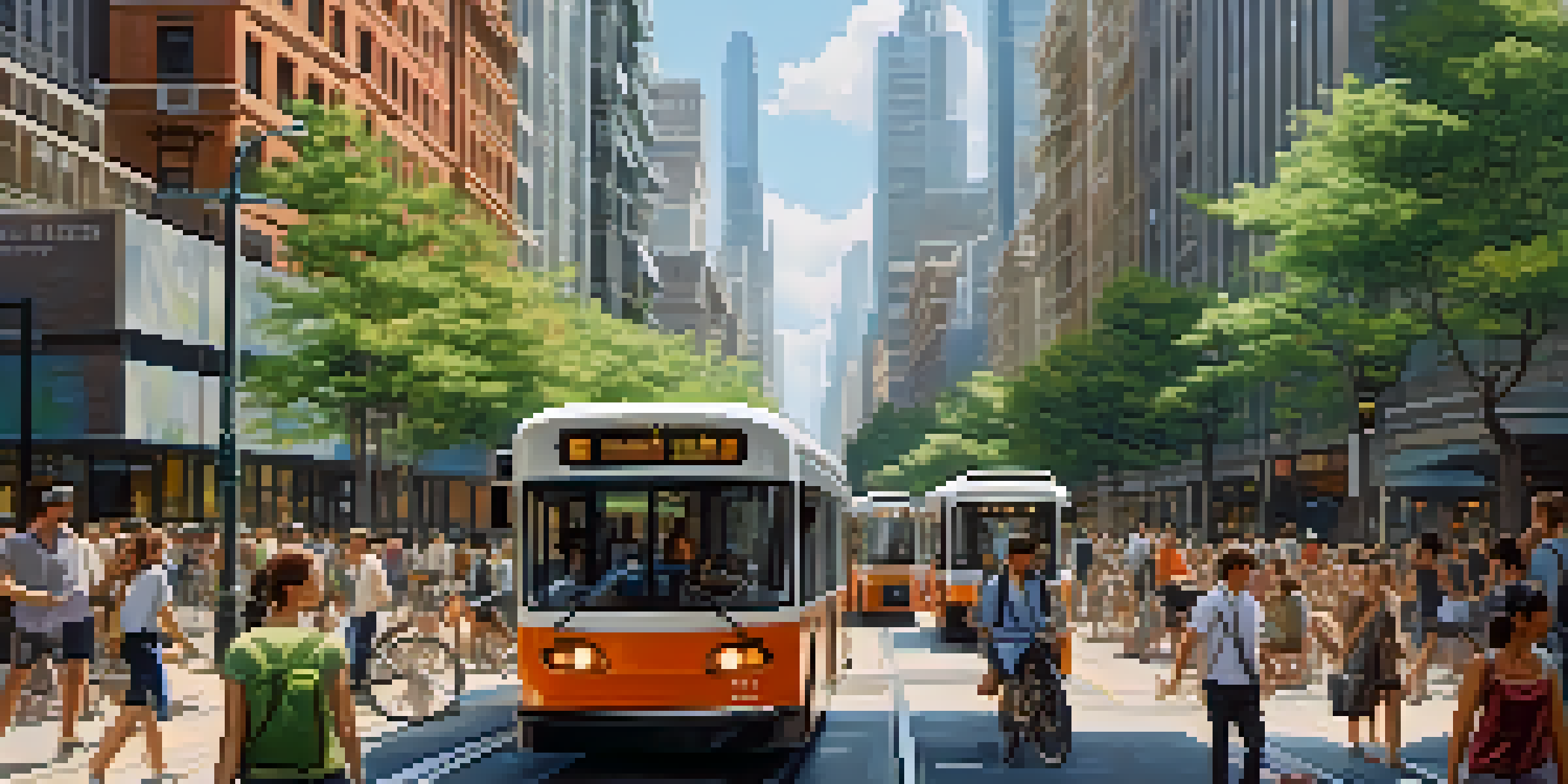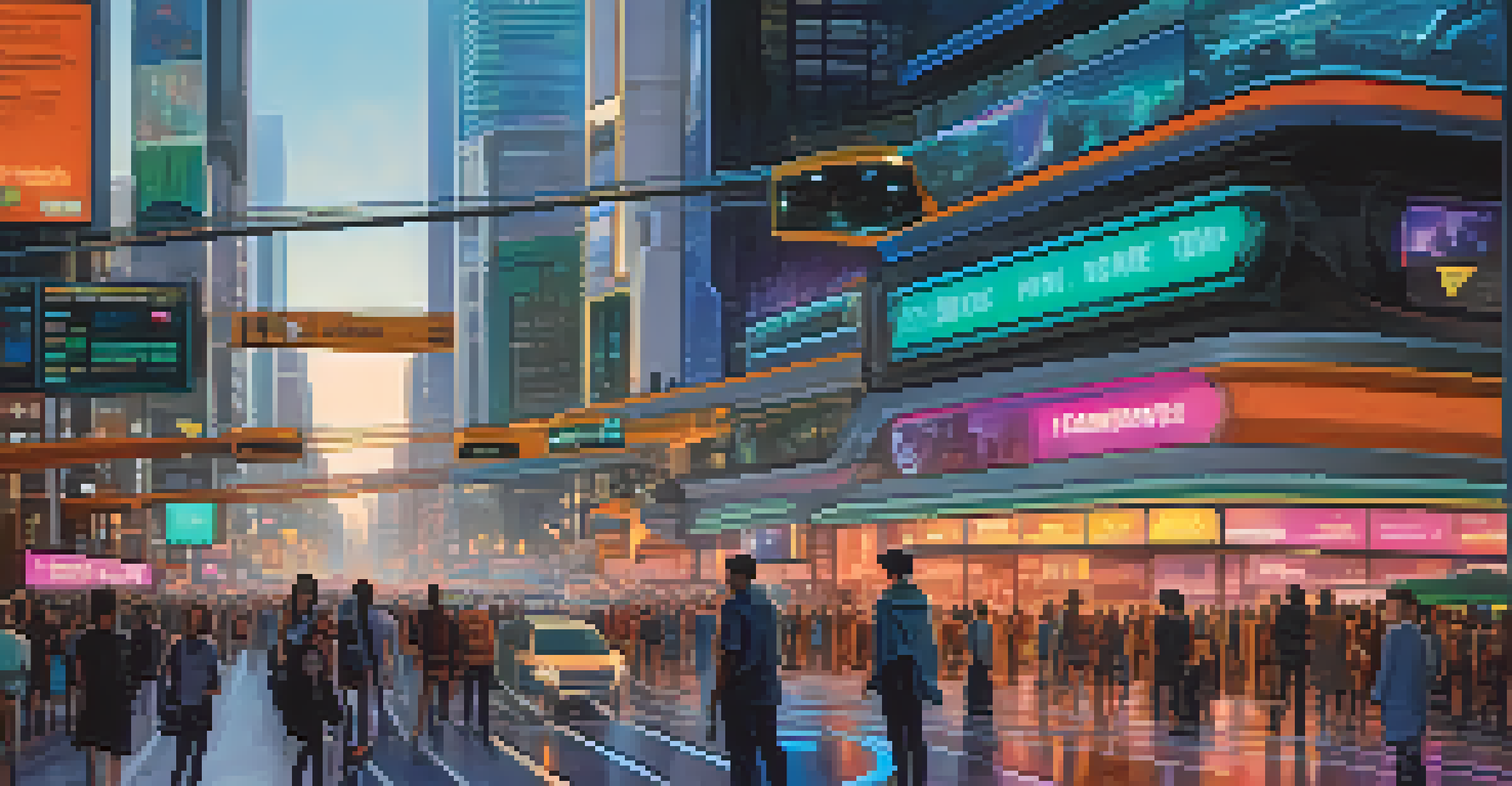How Transportation Trends Shape Future Property Values

Understanding the Link Between Transportation and Property Values
Transportation trends significantly influence property values across various regions. When new transport infrastructure, like highways or public transit, is introduced, it often leads to increased accessibility. This accessibility makes neighborhoods more desirable, consequently driving up property prices. For instance, homes near a newly built metro station tend to see a surge in value as commuting becomes more convenient.
Transportation is the skeleton of a city, and without it, the city cannot grow.
Conversely, areas that lose transport links may experience a decline in property values. If a major bus route is cut or a train station closes, residents may feel less inclined to live in those neighborhoods. This shift can lead to a decrease in demand, which directly impacts home values. It’s essential for potential buyers to consider these trends when investing.
In essence, the relationship between transportation options and property values is a crucial consideration for both buyers and investors. Understanding this dynamic can lead to better investment decisions. By staying informed about transportation developments, one can gain insights into the future potential of property values.
The Rise of Public Transportation and Its Impact
Public transportation has seen a resurgence in many urban areas, and this shift is reshaping property values. Cities investing in robust transit systems attract more residents, leading to increased demand for housing. As commuters prefer locations near transit lines, properties in these areas often see substantial appreciation. For example, cities like San Francisco have experienced property booms in neighborhoods served by light rail.

Moreover, public transportation can make living in urban centers more affordable. With effective transit options, individuals can live farther from their workplaces without sacrificing commute times. This flexibility can elevate property values in previously overlooked areas, as buyers seek affordability without compromising accessibility.
Transportation Boosts Property Values
New transport infrastructure increases accessibility, making neighborhoods more desirable and driving up property prices.
In summary, the expansion of public transportation not only enhances mobility but also boosts property values. As cities prioritize transit development, savvy investors should keep a close eye on these trends. The ability to predict how public transport projects will influence local real estate markets is invaluable.
The Shift Towards Eco-Friendly Transportation Options
As environmental concerns grow, eco-friendly transportation options have become more popular. Biking, walking, and electric vehicles (EVs) are gaining traction, influencing the way we think about property values. Areas that promote sustainable transport, like bike lanes or EV charging stations, often attract environmentally conscious buyers. This trend can lead to rising property values in neighborhoods that embrace green initiatives.
The best thing about public transportation is that it gets you where you need to go without the need for a car.
Additionally, cities focusing on reducing carbon footprints often see a shift in buyer preferences. Homebuyers may prioritize locations with easy access to parks, pedestrian paths, and public transit options. This shift can lead to increased demand for properties in such areas, driving values upward.
Ultimately, the rise of eco-friendly transportation is reshaping the real estate landscape. For investors and homeowners alike, understanding these shifts can provide a competitive edge. As the market adapts to these trends, properties that align with eco-friendly values are likely to see increased demand.
The Role of Technology in Modern Transportation
Technology is revolutionizing transportation, and its effects on property values are profound. The rise of ride-sharing services, like Uber and Lyft, has changed the way people consider location. Areas previously deemed less desirable due to distance from public transport are now more appealing, as residents can rely on these services for convenient travel. This shift can lead to increased property values in more remote neighborhoods.
Additionally, advancements in autonomous vehicles may further influence property markets. As self-driving cars become commonplace, the need for parking spaces may decrease, allowing for innovative property developments. This potential change in urban planning could reshape entire neighborhoods, impacting property values in ways we are just beginning to understand.
Public Transit Enhances Urban Appeal
Investments in public transportation lead to higher housing demand in urban areas, resulting in substantial property value appreciation.
In summary, technology’s role in transportation is not just about convenience; it’s about how we value properties. Investors should consider these tech trends when evaluating real estate potential. The future of property values is closely tied to how we adapt to and embrace technological changes in transportation.
Urban vs. Suburban: A Transportation Perspective
The ongoing debate between urban and suburban living often hinges on transportation accessibility. Urban areas typically offer better public transport options, which can drive up property values. In contrast, suburban areas may appeal to families looking for space, but their property values can fluctuate based on transport developments. For instance, the construction of new highways can enhance suburban property desirability.
As more individuals work remotely, the traditional allure of urban living is changing. People are now more willing to live in suburbs if they have reliable transportation options. This shift is prompting suburban property values to rise, particularly in areas with good transit connections. Buyers are increasingly looking for homes that balance space with accessibility.
In essence, the urban-suburban divide is evolving with changing transportation trends. Understanding this dynamic can help potential buyers make informed decisions. The right location today may differ from what it was a decade ago, highlighting the importance of transportation in real estate.
The Influence of Infrastructure Investment on Property Values
Infrastructure investment plays a key role in shaping property values. When governments allocate funds to improve roads, bridges, and public transport, the surrounding real estate often benefits. New infrastructure can transform neighborhoods, making them more appealing to both businesses and residents. For example, cities that invest in modernizing their transport systems typically see property values rise.
Moreover, infrastructure projects can signal growth and development, attracting further investments. Investors often prioritize areas with planned infrastructure enhancements, anticipating future appreciation in property values. This foresight can lead to smart investment decisions and profitable outcomes.
Eco-Friendly Trends Shape Real Estate
The rise of sustainable transportation options attracts environmentally conscious buyers, boosting property values in green-friendly neighborhoods.
In summary, infrastructure investment is a significant driver of property value changes. By observing government plans and community projects, investors can identify emerging opportunities. The correlation between infrastructure and real estate is a powerful tool for predicting market trends.
Future Trends: What to Watch in Transportation and Real Estate
As we look to the future, several transportation trends are poised to impact property values significantly. The ongoing expansion of smart transportation systems, including connected vehicles and intelligent traffic management, will likely change how we navigate cities. These innovations can enhance the efficiency of transportation networks, making certain areas more attractive for real estate investment.
Additionally, the trend towards mixed-use developments, which combine residential, commercial, and recreational spaces, is gaining momentum. These developments often prioritize walkability and accessibility, appealing to modern buyers. Areas with well-planned mixed-use developments may see property values soar as they cater to the desires of today’s consumers.

Ultimately, staying ahead of these trends is essential for anyone involved in real estate. By keeping an eye on transportation innovations and urban planning initiatives, investors can make informed choices. The future of property values will undoubtedly be shaped by how we adapt to these evolving transportation landscapes.
Conclusion: The Future of Property Values and Transportation
Understanding how transportation trends shape property values is crucial for buyers, sellers, and investors. The interplay between accessibility, infrastructure, and market demand is complex but vital. As cities evolve and adapt to new transport options, property values will continue to shift in response. Keeping a pulse on these trends can empower individuals to make informed real estate decisions.
Moreover, as we embrace sustainable and technological advancements in transportation, the landscape of real estate will transform. Properties that align with modern transportation needs will likely see a boost in value. This evolution underscores the importance of strategic planning for both individuals and communities.
In conclusion, the relationship between transportation and property values is multifaceted and dynamic. By staying informed about transportation trends, one can navigate the real estate market more effectively. The future holds exciting possibilities for those who understand this crucial connection.